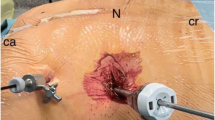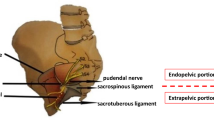Abstract
Perineal pain is the basis of presentation to different specialities. This pain is still rather unknown and leads the different teams to inappropriate treatments which may fail.
For more than twenty years, we have seen these patients in a multidisciplinary consultation. Our anatomical works have provided a detailed knowledge of the nervous supply of the perineum which allowed us to propose the description of an entrapment syndrome of the pudendal nerve. Other disturbances of different origins were highlighted helping colleagues to a better analysis of this enigmatic painful syndrome.
Cadaveric studies have been done to guide treatments by blocks and surgery if necessary according to well defined criteria.
A randomized prospective study validated the surgery. The retrospective study concluded that two thirds of the patients improved after treatment. New anatomical concepts are leading us to enlarge the field of this type of surgery, with the hope of improving the success rate.
Access this chapter
Tax calculation will be finalised at checkout
Purchases are for personal use only
Preview
Unable to display preview. Download preview PDF.
Similar content being viewed by others
References
Alevizon SJ, Finan MA(1996) Sacrospinous colpopexy: management of postoperative pudendal nerve entrapment. Obstet Gynecol 88: 713–715
Amarenco G, Lanoe Y, Perrigot M, Goudal H(1987) Un nouveau syndrome canalaire, la compression du nerf pudendal dans la canal d’Alcock ou paralysie périnéale du cycliste. Presse Med 16: 399
Amarenco G, Ismael SS, Bayle B, Denys P, Kerdraon J(2001) Electrophysiological analysis of pudendal neuropathy following traction. Muscle Nerve 24: 116–119
Antolak SJJ, Hough DM, Pawlina W, Spinner RJ(2002) Anatomical basis of chronic pelvic pain syndrome: the ischial spine and pudendal nerve entrapment. Med Hypotheses 59: 349–353
Bautrant E, deBisschop E, Vaini-Elies V et al. (2003) La prise en charge moderne des névralgies pudendales. A partir d’une sériede 212 patientes et 104 interventions de décompression. J Gynecol Obstet Biol Reprod (Paris) 32: 705–712
Bensignor-Le Henaff M, Labat JJ, Robert R, Lajat Y, Papon M(1991) Douleur périnéale et souffrance des nerfs honteux internes. Agressologie 32: 277–279
Bouhassira D, Attal N, Alchaar Het al. (2005) Comparison of pain syndromes associated with nervous or somatic lesions and development of a new neuropathic pain diagnostic questionnaire (DN4). Pain 114: 29–36
Chevallier JM, Wind P, Lassau JP(1996) La blessure des nerfs inguino-fémoraux dans le traitement de hernie. Un danger anatomique des techniques traditionnelles et laparoscopies. Ann Chir 50: 767–775
Costabile RA, Hahn M, McLeod DG(1991) Chronic orchialgia in the pain prone patient: the clinical perspective. J Urol 146: 1571–1574
Fishman LM, Schaefer MP(2003) The piriformis syndrome is underdiagnosed. Muscle Nerve 28: 646–649
France MP, Aurori BF(1992) Pudendal nerve palsy following fracture table traction. Clin Orthop 276: 272–276
Friedrich EGJ(1987) Vulvar vestibulitis syndrome. J Reprod Med 32: 110–114
Hough DM, Wittenberg KH, Pawlina Wet al. (2003) Chronic perineal pain caused by pudendal nerve entrapment: anatomy and CT-guided perineural injection technique. AJR Am J Roentgenol 181: 561–567
Krieger JN, Ross SO, Riley DE(2002) Chronic prostatitis: epidemiology and role of infection. Urology 60: 8
Labat JJ, Robert R, Bensignor M, Buzelin JM(1990) Les névralgies du nerf pudendal (honteux interne). Considérations anatomo-cliniques et perspectives thérapeutiques. J Urol (Paris) 96: 239–244
Liszka TG, Dellon AL, Manson PN(1994) Iliohypogastric nerve entrapment following abdominoplasty. Plast Reconstr Surg 93: 181–184
McCrory P(2001) The “piriformis syndrome” myth or reality? Br J Sports Med 35: 209–210
Maigne R(1981) Le syndrome de la jonction dorso-lombaire. Douleur lombaire basse, douleur pseudo-viscérale, pseudo douleur de hanche et pseudo douleur pubienne. Sem Hop 57: 545–554
Meknas K, Christensen A, Johansen O(2003) The internal obturator muscle may cause sciatic pain. Pain 104: 375–380
Mondelli M, Giannini F, Guazzi G, Corbelli P(2002) Obturator neuropathy due to obturator hernia. Muscle Nerve 26: 291–292
Perry CP(2003) Peripheral neuropathies and pelvic pain: diagnosis and management. Clin Obstet Gynecol 46: 789–796
Ramsden CE, McDaniel MC, Harmon RL, Renney KM, Faure A(2003) Pudendal nerve entrapment as source of intractable perineal pain. Am J Phys Med Rehabil 82: 479–484
Robert R, Labat JJ, Lehur PAet al. (1989) Réflexions cliniques, neurophysiologiques et thérapeutiques à partir de données anatomiques sur le nerf pudendal (honteux interne) lors de certaines algies périnéales. Chirurgie 115: 515–520
Robert R, Brunet C, Faure Aet al. (1993) La chirurgie du nerf pudendal lors de certaines algies périnéales: évolution et résultats. Chirurgie 119: 535–539
Robert R, Prat-Pradal D, Labat JJet al. (1998) Anatomic basis of chronic perineal pain: role of the pudendal nerve. Surg Radiol Anat 20: 93
Robert R, Bensignor M, Labat JJ et al. (2004) Le neurochirurgien face aux algies périnéales: guide pratique. Neurochirurgie 50: 533–539
Robert R, Labat JJ, Bensignor Met al. (2005) Decompression and transposition of the pudendal nerve in pudendal neuralgia: a randomized controlled trial and long-term evaluation. Eur Urol 47: 403–408
Roche B, Dembe JC, Mavrocordatos P, Rap JR, Cahana A(2004) Approche anatomochirurgicale des névralgies du nerf pudendal. Le courrier de l’algologie 3: 109–112
Sagsoz N, Ersoy M, Kamaci M, Tekdemir I(2002) Anatomical landmarks regarding sacrospinous colpopexy operations performed for vaginal vault prolapse. Eur J Obstet Gynecol Reprod Biol 101: 74–78
Sippo WC, Burghardt A, Gomez AC(1987) Nerve entrapment after Pfannenstiel incision. Am J Obstet Gynecol 157: 420–421
Sorenson EJ, Chen JJ, Daube JR(2002) Obturator neuropathy: causes and outcome. Muscle Nerve 25: 605–607
Soulie M, Vazzoler N, Seguin P, Chiron P, Plante P(2002) Conséquences urologiques du traumatisme du nerf pudendal sur table orthopédique: mise au point et conseils pratiques. Prog Urol 12: 504–509
Stewart JD(2003) The piriformis syndrome is overdiagnosed. Muscle Nerve 28: 644–646
Turner ML, Marinoff SC(1991) Pudendal neuralgia. Am J Obstet Gynecol 165: 1233–1236
Verdeja AM, Elkins TE, Odoi A, Gasser R, Lamoutte C(1995) Transvaginal sacrospinous colpopexy: anatomic land marks to be aware of to minimize complications. Am J Obstet Gynecol 173: 1468–1469.1a
Wesselmann U, Burnett AL, Heinberg LJ(1997) The urogenital and rectal pain syndromes. Pain 73: 269–294
Author information
Authors and Affiliations
Editor information
Editors and Affiliations
Rights and permissions
Copyright information
© 2007 Springer-Verlag/Wien
About this chapter
Cite this chapter
Robert, R., Labat, J.J., Riant, T., Khalfallah, M., Hamel, O. (2007). Neurosurgical treatment of perineal neuralgias. In: Pickard, J.D., et al. Advances and Technical Standards in Neurosurgery. Advances and Technical Standards in Neurosurgery, vol 32. Springer, Vienna. https://doi.org/10.1007/978-3-211-47423-5_3
Download citation
DOI: https://doi.org/10.1007/978-3-211-47423-5_3
Publisher Name: Springer, Vienna
Print ISBN: 978-3-211-47416-7
Online ISBN: 978-3-211-47423-5
eBook Packages: MedicineMedicine (R0)




